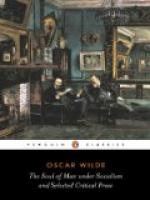With the novel it is the same thing. Popular authority and the recognition of popular authority are fatal. Thackeray’s ‘Esmond’ is a beautiful work of art because he wrote it to please himself. In his other novels, in ‘Pendennis,’ in ‘Philip,’ in ‘Vanity Fair’ even, at times, he is too conscious of the public, and spoils his work by appealing directly to the sympathies of the public, or by directly mocking at them. A true artist takes no notice whatever of the public. The public are to him non-existent. He has no poppied or honeyed cakes through which to give the monster sleep or sustenance. He leaves that to the popular novelist. One incomparable novelist we have now in England, Mr George Meredith. There are better artists in France, but France has no one whose view of life is so large, so varied, so imaginatively true. There are tellers of stories in Russia who have a more vivid sense of what pain in fiction may be. But to him belongs philosophy in fiction. His people not merely live, but they live in thought. One can see them from myriad points of view. They are suggestive. There is soul in them and around them. They are interpretative and symbolic. And he who made them, those wonderful quickly-moving figures, made them for his own pleasure, and has never asked the public what they wanted, has never cared to know what they wanted, has never allowed the public to dictate to him or influence him in any way but has gone on intensifying his own personality, and producing his own individual work. At first none came to him. That did not matter. Then the few came to him. That did not change him. The many have come now. He is still the same. He is an incomparable novelist. With the decorative arts it is not different. The public clung with really pathetic tenacity to what I believe were the direct traditions of the Great Exhibition of international vulgarity, traditions that were so appalling that the houses in which people lived were only fit for blind people to live in. Beautiful things began to be made, beautiful colours came from the dyer’s hand, beautiful patterns from the artist’s brain, and the use of beautiful things and their value and




